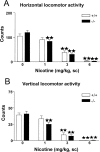Nicotine-induced antinociception, rewarding effects, and physical dependence are decreased in mice lacking the preproenkephalin gene
- PMID: 15689546
- PMCID: PMC6725961
- DOI: 10.1523/JNEUROSCI.3008-04.2005
Nicotine-induced antinociception, rewarding effects, and physical dependence are decreased in mice lacking the preproenkephalin gene
Abstract
It has been shown previously that the endogenous opioid system may be involved in the behavioral effects of nicotine. In the present study, the participation of endogenous enkephalins on nicotine responses has been investigated by using preproenkephalin knock-out mice. Acute nicotine-induced hypolocomotion remained unaffected in these mice. In contrast, antinociception elicited in the tail-immersion and hot-plate tests by acute nicotine administration was reduced in mutant animals. The rewarding properties of nicotine were then investigated using the place-conditioning paradigm. Nicotine induced a conditioned place preference in wild-type animals, but this effect was absent in knock-out mice. Accordingly, in vivo microdialysis studies revealed that the enhancement in dopamine extracellular levels in the nucleus accumbens induced by nicotine was also reduced in preproenkephalin-deficient mice. Finally, the somatic expression of the nicotine withdrawal syndrome precipitated in nicotine-dependent mice by mecamylamine was significantly attenuated in mutant animals. In summary, the present results indicate that endogenous opioid peptides derived from preproenkephalin are involved in the antinociceptive and rewarding properties of nicotine and participate in the expression of physical nicotine dependence.
Figures








References
-
- Adams ML, Cicero TJ (1998) Nitric oxide mediates mecamylamine- and naloxone-precipitated nicotine withdrawal. Eur J Pharmacol 345: R1-R2. - PubMed
-
- Bergevin A, Girardot D, Bourque MJ, Trudeau LE (2002) Presynaptic μ-opioid receptors regulate a late step of the secretory process in rat ventral tegmental area GABAergic neurons. Neuropharmacology 42: 1065-1078. - PubMed
-
- Carboni E, Bortone L, Giua C, Di Chiara G (2000) Dissociation of physical abstinence signs from changes in extracellular dopamine in the nucleus accumbens and in the prefrontal cortex of nicotine dependent rats. Drug Alcohol Depend 58: 93-102. - PubMed
-
- Castañé A, Valjent E, Ledent C, Parmentier M, Maldonado R, Valverde O (2002) Lack of CB1 cannabinoid receptors modifies nicotine behavioural responses, but not nicotine abstinence. Neuropharmacology 43: 857-867. - PubMed
Publication types
MeSH terms
Substances
Grants and funding
LinkOut - more resources
Full Text Sources
Molecular Biology Databases
